hanging
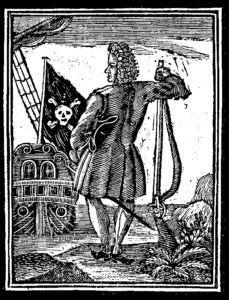 During five weeks in the fall of 1718, Charleston’s citizens observed thirteen trials involving fifty-eight men charged with piracy. Piracy was and is looked upon as a particularly heinous crime. Most of the documentation of the trials was done by clerks working feverously with quill and ink. Pirates were and are known for the viciousness of the crimes they commit. For them, it is not enough to steal the valuables from the boats to seize, they didn’t consider their attack complete until they had brutalized their victims. Piracy in that period included aggravated armed robbery, assault, murder, rape, and kidnapping at sea. It was a growing menace, and its presence at so close to colonial borders demanded and received the full attention of local authorities.
During five weeks in the fall of 1718, Charleston’s citizens observed thirteen trials involving fifty-eight men charged with piracy. Piracy was and is looked upon as a particularly heinous crime. Most of the documentation of the trials was done by clerks working feverously with quill and ink. Pirates were and are known for the viciousness of the crimes they commit. For them, it is not enough to steal the valuables from the boats to seize, they didn’t consider their attack complete until they had brutalized their victims. Piracy in that period included aggravated armed robbery, assault, murder, rape, and kidnapping at sea. It was a growing menace, and its presence at so close to colonial borders demanded and received the full attention of local authorities.
Between 1716 and 1718, several pirate ships frequently disrupted the maritime traffic entering and leaving Charleston’s port. These incidents significantly halted South 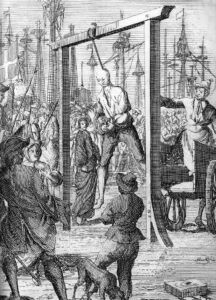 Carolina’s crucial sea trade. It was a serious matter and demanded serious repercussions. The pirate incursions were far more than mere nuisances or disruptions to trade. The fact was that they posed a real danger to the lives of many and threatened the political and economic foundations of the young colony. Unfortunately, with no local newspaper in Charleston until January 1732, there are no detailed accounts of the pirate activities of the 1710s. Finally, the provincial government of South Carolina, located in Charleston, engaged in discussions and formulated a collective response to the pirate threats of 1717 and 1718, but the particulars of their actions have mostly been lost to history. Consequently, we lack sufficient resources to fully narrate South Carolina’s brush with what our legislature once termed the “Pirates of the Bahamas.” Major Stede Bonnet’s crew consisted of Alexander Amand/Annand (from British Jamaica), Job ‘Bayley’ Baily (from London), Samuel Booth (from Charles Town), Robert Boyd (from Bath Town), Thomas Carman
Carolina’s crucial sea trade. It was a serious matter and demanded serious repercussions. The pirate incursions were far more than mere nuisances or disruptions to trade. The fact was that they posed a real danger to the lives of many and threatened the political and economic foundations of the young colony. Unfortunately, with no local newspaper in Charleston until January 1732, there are no detailed accounts of the pirate activities of the 1710s. Finally, the provincial government of South Carolina, located in Charleston, engaged in discussions and formulated a collective response to the pirate threats of 1717 and 1718, but the particulars of their actions have mostly been lost to history. Consequently, we lack sufficient resources to fully narrate South Carolina’s brush with what our legislature once termed the “Pirates of the Bahamas.” Major Stede Bonnet’s crew consisted of Alexander Amand/Annand (from British Jamaica), Job ‘Bayley’ Baily (from London), Samuel Booth (from Charles Town), Robert Boyd (from Bath Town), Thomas Carman 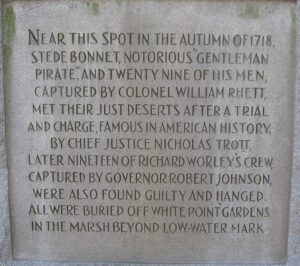 (from Maidstone, Kent), and George Dunkin (from Glasgow), to name a few, were considered particularly vicious, and their punishments would need to be vicious as well.
(from Maidstone, Kent), and George Dunkin (from Glasgow), to name a few, were considered particularly vicious, and their punishments would need to be vicious as well.
Following the trials and guilty verdicts, Major Stede Bonnet and his crew of 29 men were hanged on November 8, 1718, at White Point, Charleston, South Carolina. It had been decided that hanging just wasn’t bad enough for the crimes these men committed. I’m sure they thought long and hard about how they could show the same viciousness to these men, that they had shown to their victims. Finally, they came up with the perfect final punishment. Following their hanging, these men were buried in the marsh below the low watermark.

 George Lane was a shoemaker by trade, back in the mid 1800s. He also had a birth defect, that earned him the nickname he hated all his life…Clubfoot. In an event that seems rather unusual to me, Lane was accused of being a member of Henry Plummer’s gang of “Innocents” and was hanged by Montana Vigilantes in January 1864. Lane was a small man, originally from Massachusetts. He later made his way to the west during the California Gold Rush. Like many people back then, he dreamed of becoming rich, and the Goldrush seemed as likely a way as any other. Things didn’t exactly go as planned, and he ended up working first on a farm in Yuba County, before making his way to Calaveras County, where he worked as a store clerk. Not quite the glamorous outcome he had in mind.
George Lane was a shoemaker by trade, back in the mid 1800s. He also had a birth defect, that earned him the nickname he hated all his life…Clubfoot. In an event that seems rather unusual to me, Lane was accused of being a member of Henry Plummer’s gang of “Innocents” and was hanged by Montana Vigilantes in January 1864. Lane was a small man, originally from Massachusetts. He later made his way to the west during the California Gold Rush. Like many people back then, he dreamed of becoming rich, and the Goldrush seemed as likely a way as any other. Things didn’t exactly go as planned, and he ended up working first on a farm in Yuba County, before making his way to Calaveras County, where he worked as a store clerk. Not quite the glamorous outcome he had in mind.
In 1860, gold was discovered in Washington Territory, and Lane once again followed the miners, with plans to “get rich quick” forming in his head. Again, Lane ran into trouble. This time in 1862 when a Lewiston, Idaho rancher accused him and another man of “running off horses.” That “crime” didn’t really seem as serious as the rancher supposed, but then I am not a lawman. Wanting to straighten things out, Lane turned himself into the Fort Lapwai commander, who assigned them to help with building construction. The following year, he and another man were accused of a similar crime, this time, driving a stolen horse herd toward the Snake River. The alleged horse thieves escaped, and by the fall of 1863, Lane had made his way to Virginia City, Montana. His situation and the oddly recurring events, make you wonder if he was as innocent as he claimed. He did, after all, run from the law his time. He soon went to work for Dance and Stuwart’s Store, mending harnesses and making and repairing boots. It would appear that he was at least trying to lead an honest life.
Lane began earning the respect of his employers. Nevertheless, he again came under suspicion when he rode to Bannack, Montana, to inform Henry Plummer of the George Ives trial taking place in Nevada City in December 1863. Though Plummer was absent at the time, Lane told Deputies Ray and Stinson of the growing vigilance movement in Virginia City. It would seem to me that when you are suspected of being a part of a criminal gang, that should be the furthest thing from your thoughts, if you want to look innocent anyway. Because of that trip, when the Vigilance Committee met the following month, Lane’s name immediately came up as a “spy” for the outlaw gang called The Innocents.
On January 14, 1864, Lane was arrested at Dance and Stuart’s store. When he asked why he was being arrested, the men informed him, “For being a road agent, thief, and an accessory to numerous robberies and murders on the highway.” Lane responded by saying, “If you hang me, you will hang an innocent man.” While his bosses liked and respected Lane, they assumed that the vigilantes had evidence against Lane, so they did not intervene. Not everyone thought Lane was guilty, but the Committee tried him anyway and found him guilty. He was sentenced to be hanged along with Frank Parish, Boone Helm, Haze Lyons, and Jack Gallager. Lane requested a minister be brought before he was executed which was scheduled to be the first execution. Then, as he was forced to stand on a box under the noose, Lane saw a friend. He yelled out, “Goodbye, old fellow; I’m gone.” He then leaped from the box without waiting for it to be removed…going out on his own terms. He and the others hanged that day were buried in Virginia City’s Boot Hill Cemetery. As punishment, none of the graves were given markers.
Placing no markers while maybe a “fitting punishment” can later pose a problem. Weh people began to ask who 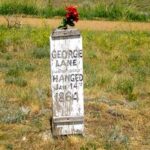
 was in these graves, some 43 years later, it brought in question the deaths. In 1907, a former vigilante came forward, saying that he knew the order of the graves, and which one was Club Foot George’s. Their curiosity peaked now, the city soon dug up the grave that was allegedly Clubfoot George Lane’s. Everyone was surprised when he had been right. The deformed foot belonging to George Lane was indeed in the grave. The foot bones were then placed in a cabinet in the courthouse. Later, they were moved and placed on display in a glass jar at the Thompson Hickman Museum in Virginia City, Montana.
was in these graves, some 43 years later, it brought in question the deaths. In 1907, a former vigilante came forward, saying that he knew the order of the graves, and which one was Club Foot George’s. Their curiosity peaked now, the city soon dug up the grave that was allegedly Clubfoot George Lane’s. Everyone was surprised when he had been right. The deformed foot belonging to George Lane was indeed in the grave. The foot bones were then placed in a cabinet in the courthouse. Later, they were moved and placed on display in a glass jar at the Thompson Hickman Museum in Virginia City, Montana.

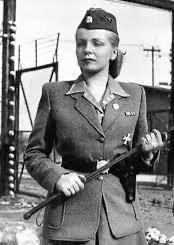 Raised by farming parents, who hated Nazis and all that they stood for, didn’t stop Irma Grese from wanting to join the Bund Deutscher Mädel or League of German Girls. Nevertheless, her father forbade it. Irma Elisabeth Ilse Ida Grese was born to Berta Grese and Alfred Grese, both dairy workers, on October 7, 1923. She was the third of five children (three girls and two boys). While Irma was an “angelic” looking girl with blond hair and blue eyes, there was something else living behind those eyes, a determination to get what she wanted…no matter the cost. In 1938 at the age of 15, Irma left school and worked as an assistant nurse in the sanatorium of the SS.
Raised by farming parents, who hated Nazis and all that they stood for, didn’t stop Irma Grese from wanting to join the Bund Deutscher Mädel or League of German Girls. Nevertheless, her father forbade it. Irma Elisabeth Ilse Ida Grese was born to Berta Grese and Alfred Grese, both dairy workers, on October 7, 1923. She was the third of five children (three girls and two boys). While Irma was an “angelic” looking girl with blond hair and blue eyes, there was something else living behind those eyes, a determination to get what she wanted…no matter the cost. In 1938 at the age of 15, Irma left school and worked as an assistant nurse in the sanatorium of the SS.
As I looked at Irma’s life, I wondered how she could have possibly gone in such a horrific direction with the parents she had. Then, I realized that in Germany in the 1930s, parents were quickly losing the right to raise their own children. They had no control over the education process, and in fact, the Nazi regime was quickly making the children believe that their parents were uneducated and stupid. The Nazi regime backed the “right” of the children to choose their destiny…provided it was “in sync” with the Nazi agenda. In 1936, her mother died by suicide after drinking hydrochloric acid following the discovery of Alfred’s affair with the local pub owner’s daughter. This might have contributed to Irma’s coming disobedience.
Despite Alfred, her farmer father’s objections, Irma was determined to join the Nazi party, because of the opportunity to become a nurse that they were offering her. She began studying at Hohenlychen, a SS hospital as an assistant nurse, in 1939. During her time there, she worked with Dr Karl Gebhardt, who performed medical experiments on patients, but he was unsuccessful at nursing and moved on to be a machinist. Once she was 18, she joined the Aufseherinnen SS and, after passing the necessary examinations, entered training at Ravensbrück. At Ravensbrück, Irma trained for three weeks (the program was a month, but Irma was an eager learner, and so went through it in three weeks). It is believed that she also had numerous relationships with male officers, which may have helped to “cut down” on her education time.
In 1943, Irma was sent to Auschwitz-Birkenau to guard female prisoners and was promoted the following year to the second-highest position within the Aufseherinnen at the camp. Due to her transfer, Irma had a falling out with her father, as he had been vehemently opposed to her joining the SS entourage, and he expelled her from the house. She oversaw 30,000 female prisoners at Auschwitz-Birkenau, and she was known to be brutal. The inmates at Auschwitz nicknamed her The Hyena of Auschwitz…probably because of the fact that she delighted in their pain. She wore heavy boots, carried a whip, and a pistol. While her appearance was that of a kindly person, she was known to have an affinity for kicking and beating prisoners, walking around camp with two hungry dogs trained to kill, and generally inflicting pain upon anyone who committed the slightest offense. She took pleasure in having the camp doctor operate on prisoners without anesthetic and, according to Dr Gisella Perl (the woman who performed an abortion for Irma on one occasion), she enjoyed the “sight of this human suffering. Her tense body swung back and forth in a revealing, rhythmical motion. Her cheeks were flushed and her wide-open eyes had the rigid, staring look of complete sexual paroxysm.”
Irma was transferred to Ravensbrück in January 1945, before being sent to Bergen-Belsen in March…where 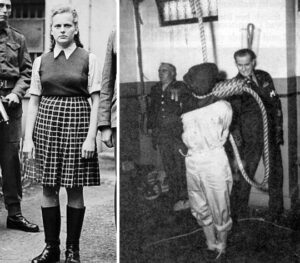
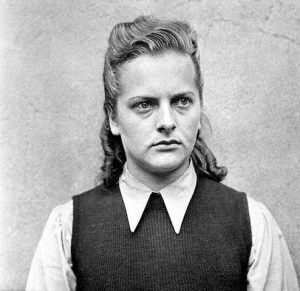 her brutal behavior continued. She enjoyed torturing the women under her control. She made women kneel for long periods of time, or hold large rocks over their heads, or stand in the snow or rain for hours. She felt no pity. Irma was captured by British soldiers in April 1945 and put on trial soon after. She claimed that she was just following orders and serving the state. She showed no remorse…even as she was sentenced to hang. Irma was hanged on December 13, 1945. At the age of 22, she was the youngest Nazi criminal to be executed.
her brutal behavior continued. She enjoyed torturing the women under her control. She made women kneel for long periods of time, or hold large rocks over their heads, or stand in the snow or rain for hours. She felt no pity. Irma was captured by British soldiers in April 1945 and put on trial soon after. She claimed that she was just following orders and serving the state. She showed no remorse…even as she was sentenced to hang. Irma was hanged on December 13, 1945. At the age of 22, she was the youngest Nazi criminal to be executed.
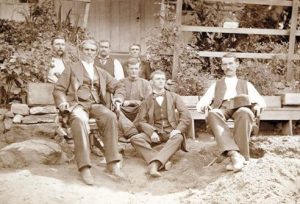 When the ranchers began to take over the western plains, there were those who were honest, and those who were scoundrels. One of those scoundrels was Albert John Bothwell (1855-1928), who was one of the main instigators of the Johnson County War in Wyoming. Bothwell was born in Iowa and migrated to Wyoming, where he quickly became one of the most prosperous cattlemen in Sweetwater County. Bothwell was an arrogant man, who tended to take what he wanted. He had been grazing his cattle on unclaimed homestead land, which was not his to use, but as I said, he tended to take what he wanted. When James Averell and his girlfriend, Ellen Watson came along in 1886, and filed a claim on the land Bothwell had been using, they found that he had gone so far as to illegally fence much of their land with barbed wire. In his mind, Bothwell
When the ranchers began to take over the western plains, there were those who were honest, and those who were scoundrels. One of those scoundrels was Albert John Bothwell (1855-1928), who was one of the main instigators of the Johnson County War in Wyoming. Bothwell was born in Iowa and migrated to Wyoming, where he quickly became one of the most prosperous cattlemen in Sweetwater County. Bothwell was an arrogant man, who tended to take what he wanted. He had been grazing his cattle on unclaimed homestead land, which was not his to use, but as I said, he tended to take what he wanted. When James Averell and his girlfriend, Ellen Watson came along in 1886, and filed a claim on the land Bothwell had been using, they found that he had gone so far as to illegally fence much of their land with barbed wire. In his mind, Bothwell 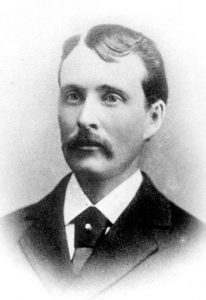 had decided that the land was somehow his, that his needs were more important, or that no one would ever put in a claim on it, at least not if he had any say in the matter.
had decided that the land was somehow his, that his needs were more important, or that no one would ever put in a claim on it, at least not if he had any say in the matter.
When Averell and Watson moved onto the land, Bothwell’s illegal use of the property came to light, and of course, led to repeated disputes between Bothwell and the young couple. Bothwell, was a powerful man, as many cattle barons are. They have men to keep what they believe to be theirs protected. The problem here was that the land wasn’t his…it belonged to Averell and Watson. When Averell wrote to the Casper Daily Mail criticizing Bothwell and claiming that the cattle barons had too much power, Bothwell retaliated by claiming that Averell and Watson were stealing his cattle. Dubbing Watson with the moniker of “Cattle Kate,” he also accused her of being a prostitute who sometimes accepted stolen cattle in payment.
As the dispute continued to rage over the next several months, Bothwell convinced other area ranchers of Averell and Watson’s guilt, and on July 20, 1889, he convinced five other men to help him hang the pair at a 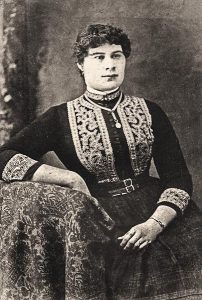 small canyon by the Sweetwater River. Though the men were charged with murder, key witnesses began to mysteriously die or disappear and all of them were acquitted. Both Averell and “Cattle Kate” were “tried” in the press, which was owned or influenced by the cattle barons, and branded as “outlaws.” Bothwell later acquired both homesteads of the murdered victims.
small canyon by the Sweetwater River. Though the men were charged with murder, key witnesses began to mysteriously die or disappear and all of them were acquitted. Both Averell and “Cattle Kate” were “tried” in the press, which was owned or influenced by the cattle barons, and branded as “outlaws.” Bothwell later acquired both homesteads of the murdered victims.
After the dust settled and many years had passed, re-investigations into the whole affair have found that most likely neither James Averell, nor his girlfriend Ellen “Cattle Kate” Watson, were guilty of any crime. In the meantime, this event, as well as several other similar events, led to the Johnson County War in Wyoming. Albert Bothwell, however, walked away free of any repercussion and continued to run his ranch until his retirement, when he moved to Los Angeles, California, where he died on March 1, 1928. No one was ever prosecuted for the murders of James Averell and Ellen Watson.

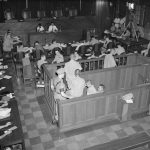 We all know that war is a nasty, messy, vicious event. Nevertheless, sometimes war is necessary. Unfortunately, in our world, evil exists, and sometimes the evil is in the form of a dictator, a nation, or a religious group. Wars might be fought differently, but the end result is the same…death and destruction. Still, most wars have an ending point. One side surrenders, and admits defeat. That might seem like the end of the story, but it isn’t. All too often the process of cleaning up the mess after the war, takes far longer than the war itself. In fact, sometimes the cleanup never really happens at all. Such was the case with landmines in Angola. These mines are a legacy of over four decades of fighting during a 14 year war of independence against its former colonial ruler of Portugal and another 30 years of civil war. Like people who put signs up to advertise a garage sale, sometimes they don’t remember where all the landmines were, or maybe they did, and simply didn’t care. Either way, the landmines were killing and maiming people…innocent people. That was the mission my 16th cousin once removed, Princess Diana took upon herself. She wanted an international ban on landmines. Her comments, which were made during a January 15, 1997 visit to Angola to see for herself some of the victims of landmines, were seen as out of step with government policy by the Junior Defense Minister, Earl Howe, who described the princess as a “loose cannon”, ill-informed on the issue of anti-personnel landmines. Nevertheless, Diana was right about the weapons of war that were left behind. The task of cleaning up the mess may have been a daunting one, but the result of leaving them behind was gruesome.
We all know that war is a nasty, messy, vicious event. Nevertheless, sometimes war is necessary. Unfortunately, in our world, evil exists, and sometimes the evil is in the form of a dictator, a nation, or a religious group. Wars might be fought differently, but the end result is the same…death and destruction. Still, most wars have an ending point. One side surrenders, and admits defeat. That might seem like the end of the story, but it isn’t. All too often the process of cleaning up the mess after the war, takes far longer than the war itself. In fact, sometimes the cleanup never really happens at all. Such was the case with landmines in Angola. These mines are a legacy of over four decades of fighting during a 14 year war of independence against its former colonial ruler of Portugal and another 30 years of civil war. Like people who put signs up to advertise a garage sale, sometimes they don’t remember where all the landmines were, or maybe they did, and simply didn’t care. Either way, the landmines were killing and maiming people…innocent people. That was the mission my 16th cousin once removed, Princess Diana took upon herself. She wanted an international ban on landmines. Her comments, which were made during a January 15, 1997 visit to Angola to see for herself some of the victims of landmines, were seen as out of step with government policy by the Junior Defense Minister, Earl Howe, who described the princess as a “loose cannon”, ill-informed on the issue of anti-personnel landmines. Nevertheless, Diana was right about the weapons of war that were left behind. The task of cleaning up the mess may have been a daunting one, but the result of leaving them behind was gruesome.
Of course, these weren’t the only messes that needed to be cleaned up after a war. There were buildings to be rebuilt, the dead to bury, the economy to build up, and the government often had to be restructured. The country might have been the enemy, but if things weren’t handled right after the surrender, the same evil people might move right back into power. Of course, cleaning up the mess…often known as policing the nation that has now surrendered, is no easy task either. Most people don’t want the winning army there. Their country is nothing like it used to be. Some believe that is a good thing, but it was still their home, and now everything feels…wrong. Their homes are destroyed, food is can be scarce…water too. Everything they have known for their whole life is gone. No wonder they don’t want the army there…or maybe they secretly do, because their home has become just a very scary place. I suppose that is why a part of the surrender agreements include restoration of the country, and the new government and police.
One more part of cleaning up the mess is the task of trying the perpetrators for their war crimes. That was the main reason that Hitler took his own life. He knew that he would be tried and convicted of the crimes he had committed, and he couldn’t face what would follow. He would have been left to the mercy of his countrymen, 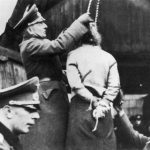
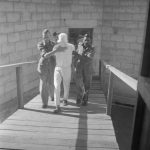 and he would have ended up being hung, like Saddam Hussein was for his war crimes. A dictator can’t brutally kill the people who he is in power over and not be hated…truly hated, no matter what the people act like when they are forced to act loyal. The trials for war crimes in many ways seems to the world, as if one nation is trying to be the world police. The United States has been accused of this before, but the reality remains, that someone has to try these evil criminals, and someone has to clean up the mess. In the absence of another nation to step up, the job usually falls to the United States.
and he would have ended up being hung, like Saddam Hussein was for his war crimes. A dictator can’t brutally kill the people who he is in power over and not be hated…truly hated, no matter what the people act like when they are forced to act loyal. The trials for war crimes in many ways seems to the world, as if one nation is trying to be the world police. The United States has been accused of this before, but the reality remains, that someone has to try these evil criminals, and someone has to clean up the mess. In the absence of another nation to step up, the job usually falls to the United States.

 I have always been somewhat amazed that, after a war is over, it seems that there must follow a trial for war crimes. It isn’t so much the trial, the obvious crimes against humanity that are always a part of war, or even the outrage over it all, that most amazes me, but rather the fact that even in war, people are expected to follow certain standards, or rules of engagement. I think that there are evil people on either side of a war, but some wars seem to have more evil involved than others…or maybe we were just more appalled in earlier wars. I think that is a possibility, because we have all become less shocked by the heinous acts people are able to perform. Still, I am completely shocked that they can stomach such things without becoming violently ill.
I have always been somewhat amazed that, after a war is over, it seems that there must follow a trial for war crimes. It isn’t so much the trial, the obvious crimes against humanity that are always a part of war, or even the outrage over it all, that most amazes me, but rather the fact that even in war, people are expected to follow certain standards, or rules of engagement. I think that there are evil people on either side of a war, but some wars seem to have more evil involved than others…or maybe we were just more appalled in earlier wars. I think that is a possibility, because we have all become less shocked by the heinous acts people are able to perform. Still, I am completely shocked that they can stomach such things without becoming violently ill.
The horrible crimes committed against the Jews and the Gypsies prior to and during World War II, were crimes 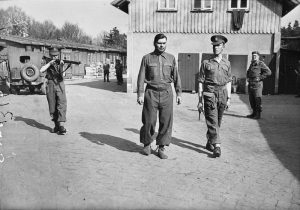 that the Allies simply could not overlook. The Belsen trial was one of several trials the Allied occupation forces held against former officials of Nazi Germany after the end of the war. The Belsen trial took place in Lüneburg, Lower Saxony, Germany in 1945. The defendants were men and women of the SS as well as prisoner officials who had worked at various concentration camps, notably Auschwitz and Bergen-Belsen. People around the world were interested in these trials, and as the public heard for the first time from some of those responsible for the mass murder in the eastern extermination camps, they were filled with contempt. Some later trials are also referred to as Belsen trials, a name that became synonymous with war crime trails of World War II.
that the Allies simply could not overlook. The Belsen trial was one of several trials the Allied occupation forces held against former officials of Nazi Germany after the end of the war. The Belsen trial took place in Lüneburg, Lower Saxony, Germany in 1945. The defendants were men and women of the SS as well as prisoner officials who had worked at various concentration camps, notably Auschwitz and Bergen-Belsen. People around the world were interested in these trials, and as the public heard for the first time from some of those responsible for the mass murder in the eastern extermination camps, they were filled with contempt. Some later trials are also referred to as Belsen trials, a name that became synonymous with war crime trails of World War II.
When the trials ended, and those who chose to commit such horrible acts as the Holocaust, Porajmos, and other war related crimes were found guilty, it was time for the next step in the justice process…carrying out the 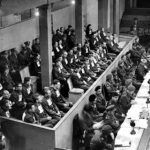
 sentencing. A report was made on November 18, 1945, regarding the completion of the Belsen Trial the day before, and the final outcome of said trial. Then, on December 13, 1945, Joseph Kramer and Irma Grese, the monarchs of Belsen were two of the people hanged for Nazi concentration camp crimes, according to the sentences imposed on them after the trial. Nine other concentration staff members were also hanged on the same day. Sentencing and the carrying out of said sentence was certainly handled more quickly than they would have been in this day and age.
sentencing. A report was made on November 18, 1945, regarding the completion of the Belsen Trial the day before, and the final outcome of said trial. Then, on December 13, 1945, Joseph Kramer and Irma Grese, the monarchs of Belsen were two of the people hanged for Nazi concentration camp crimes, according to the sentences imposed on them after the trial. Nine other concentration staff members were also hanged on the same day. Sentencing and the carrying out of said sentence was certainly handled more quickly than they would have been in this day and age.

